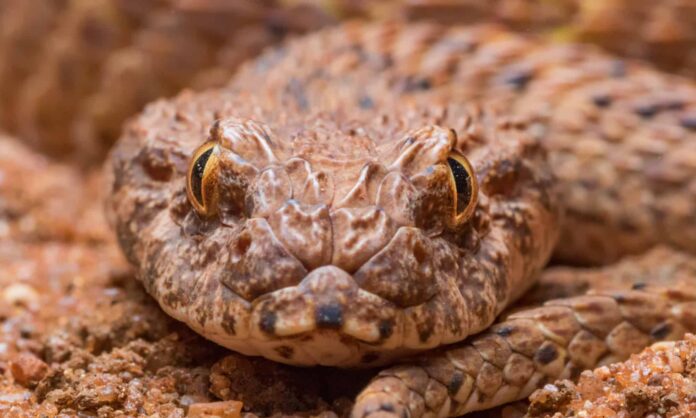Death Adder Snake, scientifically known as Acanthophis Antarcticus, are extremely venomous and nocturnal snakes that have their natural habitat in most of Australia and Papua New Guinea, not just on the mainland but also on the small offshore island around the continent. The death toll from envenomation was estimated at around ~50% before the development of an antidote in Australia in 1958.
Death Adder Snake Venom|
The venom of death adder snake is extremely dangerous and if you have come in contact with it, consult a doctor as soon as possible. The venom of death adder is neurotoxic, which leads to the loss of control in the muscular system by post-synaptic blockage of neuromuscular transmission.
This eventually leads to failure of the respiratory system and will lead to death unless the victim is given assisted breathing. Ranging from various symptoms found in a victim who came in contact with the death adder’s venom are enlargement of regional lymph nodes, paralysis, and abdominal pains.
However, there have been reports claiming that people who death adder snakes bit didn’t feel any of these symptoms and didn’t require any antidote for the venom, it is because not every bite of a snake contains the venom generating venom for a snake is also costly task.
They sometimes give their opponents or potential threats a warning bite. This shows that venomous bites are a voluntary movement by the snakes depending on the level of threat the face.
Read More- 9 Fascinating Birds of Colorado State
Death Adder Snake’s Bite|
Since these snakes are extremely venomous and are nocturnal and cryptic, they can have an average fang length of around 6.22mm, and inhabit with humans or pets is not a good idea since every snake sees another organism as a potential threat and may attack if they feel threatened.
According to various reports, dogs who get bit by death adder snakes show the symptoms of paralysis in their legs, which eventually harms their lungs and other parts of the body. And this torture lasts around 20 minutes for a dog. To save a pet victim, the owner must use the antidote before the victim shows any symptoms. And only then can the pet may have a better chance of survival.
Death Adder Snake Habits|
Their arrogant and reluctant nature of not retreating even when they get a potential threat has given them a nickname, Deaf Adder snakes. They are generally outlier snakes as, unlike other venomous snakes in Australia, they don’t go hunting; they wait for the prey to ambush the victim.
These snakes have camouflaged patterns all over their body, making them incredible ambush predators or Invisible predators. They usually stay motionless or snuggle under a litter of leaves under a tree to stay hidden. Not only to hunt but also to use this technique to defend themselves from their opponent. However, this makes it very dangerous for casual hikes or land workers and easy for professional snake handlers as they know where to look for them.
Death Adder Snake Structure|
The structure of a death adder varies in so many sizes and shapes. Unlike other snakes like the elapid snake, which is long and slender, death adder snakes are short in length but broad in girth. This muscular size makes them one of the fastest striking snakes in the world and the strongest. Due to their striking similarity with the shape of viper snakes, like having a thin neck and thin tail with a triangular head, they are also confused with vipers.
Read More- Know Everything About Fish Eating Birds
Death Adder Snake Life Science|
Since there have not been many studies about their ecology, little is known about it. Some evidence suggests that they stay safe in their habitat for months and come out to prey when it’s warm outside, and that is when they are spotted on roads and even inside people’s houses.
Even though some animals don’t feed on death adder snakes, people have reported seeing animals kill these snakes for safety and territorial disputes. According to some reports, a currawong was once seen fighting a death adder until it was lying dead by pecking its beak on the snake’s head. Generally, lizards named Goannas are the direct opponent of the death adder as they prey on them for their food. And small death adders fall prey to several other predators, including kookaburra birds.
Read More-WHAT IS THE SCIENTIFIC NAME FOR PIG
Death Adder’s Diet|
Caudal luring, a technique used by the death adder to catch its prey, is unlike the green tree python’s technique, in which it hangs from a tree branch to catch rodents. Mostly death adder hunts and eats skinks, frogs, and other mammals as they are easy and small to hunt.
Death Adder Safety Measures|
People living in the area with the potential risk of sighting a Death adder must be extra careful when going out during the night, keep their pets inside, and have them trained not to bite and attack the snake as it will bite back in defense. Some people also claimed that most people walk past a pile of leave without knowing that a dead snake might be inside. So people must follow precautionary steps to avoid casualties living in high-risk zones.
Read More- Are Deer With Fangs Real?
Frequently Asked Questions (FAQs)|
- Why is it called Death Adder snake?
Since their venom is neurotoxic and will kill a victim in under 20 minutes by paralyzing the muscular system that, eventually paralyzes the respiratory system. - How big is the Death Adder Snake?
Muscular in size due to their broader girth, these snakes are around 45 to 90cms long ( 18 to 35 inches). - Is death adder the most venomous snake?
It is not the most venomous, but it is one of the most venomous snakes globally, as its venom is extremely dangerous and will kill its victim quickly.
Read More – Albino Squirrel | Things You Must Know!

















